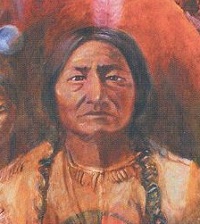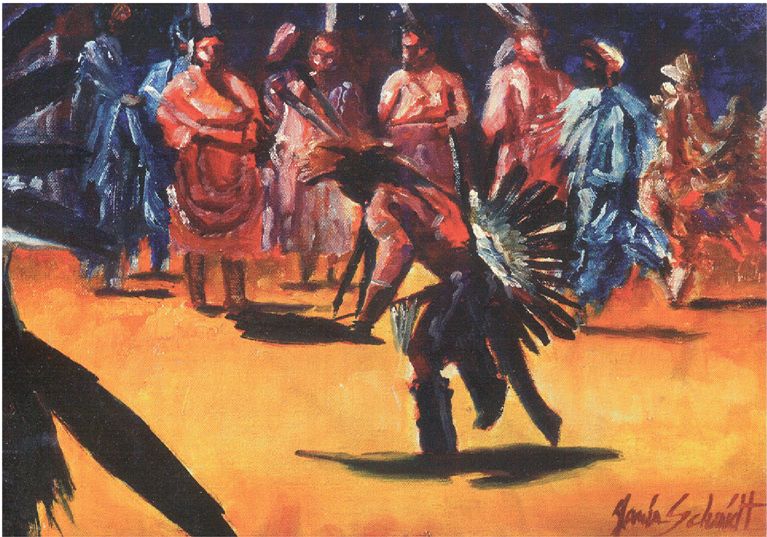 |
I, Janis Schmidt, am making available, two prints from a limited edition of 500, signed and numbered. I will dedicate the print to you for our fight against injustice.
I will donate half of the proceeds to Lawless America for whatever Bill needs to help with the filming of people’s stories of injustice. I will send the proceeds to Bill, along with names of contributors and amounts so he has a record of that. Should you wish to remain anonymous, you may do so.
The print offers you something of worth and tangible for your donation. Scroll down for instructions on how to order a print. We live in extremely troubled times, where the dollar has lost its value. Investing in good art is a sound investment, one that not only will hold its value, but also increase in value.
Scroll down to read my biography.
Sitting Bull’s Way of Life
Janis Schmidt
Limited edition of 500, 20” x 16”
From original oil on canvas
$200

This painting is much more than just a portrait of Sitting Bull; it represents the American Indian life that Sitting Bull fought so hard to preserve. In the end, he surrendered so that his people would not be rubbed off the face of the earth, which is what Americans to do, for the theft of Indian land,. They didn’t rub out the Indians, but they managed to rub out the American Indian cultural identity. Sitting Bull never gave in, and insisted on practicing the old ways. On his chest is the Indian religious icon representing the 4 Directions: black for the west, red the north, yellow the east, and white the south. Indians believed in 4 as a sacred number. They believed that all life was sacred and must be respected because it is all related. He lived his life with respect, courage, generosity, and wisdom. Birds and animals were his equals; they taught him things about nature. He had a custom of going into a sweat lodge to purify himself, both inner and outer. Inside a little round hut covered with hides for total darkness like the womb, he brought heated rocks, water, which combined with the air from the fire. When he came out, he smoked a pipe and offered prayers for the sick, the birds, and the animals. To the right are his warriors, and to the left, his people. Sitting Bull was one of the most intelligent men who ever lived, which is why the American generals and agents hated him so, because his people loved and still followed him. America hatched a plan to kill Sitting Bull by spreading the false rumor that Sitting Bull was going to lead a war party against the U.S. So in 1890, they paid off some American Indian scouts to go arrest Sitting Bull and ended up killing both him and his son, pictured behind Sitting Bull.
Sitting Bull lived at a time when the Indians were free but threatened with extinction. American Indians from the northern Great Plains chose Sitting Bull as their overall chief, leader. And he and his Indian warriors wiped out Custer. Many commissioners and Senators came to try get Sitting Bull to sign away his land, which he would never do. This is why his words got recorded, and his words give some idea of his great, great mind. “Behold, my brothers, the spring has come; the earth has received the embraces of the sun and we shall soon see the results of that love! Every seed has awakened and so has all animal life. It is through this mysterious power that we too have our being and we therefore yield to our neighbours, even our animal neighbours, the same right as ourselves, to inhabit this land. Yet hear me, my people, we have now to deal with another race – small and feeble when our fathers first met them, but now great and overbearing. Strangely enough they have a mind to till the soil and the love of possessions is a disease with them . . . They claim this mother of ours, the earth, for their own, and fence their neighbours away; they deface her with their buildings and their refuse. They threaten to take [the land] away from us. My brothers, shall we submit, or shall we say to them: “First kill me before you take possession of my Fatherland.”
[Sitting Bulls Speech at the Powder River Council, 1877.]
Traditional Dancer
Janis Schmidt
Limited edition of 500, 9” x 12”
$100

The gathering of Indians always included dancing. The dance, done in a circle, represented the circle of life. In men’s traditional dance, a story of bravery, or the story of the hunt is acted out. Traditionally the men would come home from their venture and act out their accomplishments to the villagers. This form of storytelling has been handed down for centuries. The traditional dancer wears a bustle of eagle feathers. If he allows his feathers to touch the ground, he must go into a sweat to purify himself. Dancing also had a religious purpose, as in the Sun Dance. This is not a depiction of a sun dancer. Dancing was always accompanied by drumming and songs. Some of the old songs are still sung today. After Sitting Bull’s death in 1890, the U.S. Government through the Interior Department, made it a crime for Indians to dance, or even practice their religion. It wasn’t until 1978 that a federal statute allowed Indians to dance and practice their religion. Very sadly, dancing has been relegated to the Pow Wow circuit in which dancers compete with each other for money. While I am not saying this is a bad thing, it has been Americanized and does not represent dancing as it was meant to be in Sitting Bull’s day. Back then, the dance had power, such as Sitting Bull dancing a sun dance where it was revealed to him that the Indians would have a mighty victory over the US, which just a few months later, Sitting Bull and 7 Indian tribes wiped out Custer.
PARTIAL BIOGRAPHY
I was born and raised on a farm in North Dakota in 1946. I knew I was an artist from the time I was little, but I had no access to any training, so I had to self train. I attended some oil painting workshops which helped me develop technical skill. I had mastered still lifes and landscapes, but I felt I needed to go to an art school to get training in human anatomy and life drawing because I wanted to depict something about life. I attended Rocky Mountain School of Art in Denver, Colorado, 1979-80. I took life drawing and foundation classes from Phil Steele, the founding director. I took classes from Jim Valone, who taught a philosophy as well as art. There was truly an art spirit that existed at that school that I never found anywhere else. I participated in many art shows throughout the region, earning a Best of Show at Albuquerque, NM, on a close up of water flowing over rocks in a mountain stream. I received a Best of Show from the Sidney Art Museum, Sidney, MT, and the Museum also purchased the painting, a still life.. I received a Best of Show from Aurora Fine Art Show, a large painting of rocks under water. A Denver oil corporation bought 3 of my paintings for their permanent collection, paintings of impressionistic landscapes. Jocelyn Art Museum purchased one of my paintings for their permanent collection, a portrait. I have done many commissioned portraits. My life took a sharp turn when my son was killed in 1987 when a self-styled Rambo stabbed my Damon to death after Damon said that the US had no business going down to Central America to kill Indians, and Ollie North was no hero. I was drawn to the Pine Ridge Reservation, when I live for 16 years. I discovered that everything I had ever heard about Indians was false. I learned their true history.
ORDERING
To order, send a check or money order to:
Janis Schmidt
418 Griffin Street
Warwick, ND 58381
701-294-2106
Jlschmdit@gondtc.com
Sitting Bull’s Way of Life, 16” x 20”, $200 plus $8.00 shipping and postage …………$208.00
Traditional Dancer, 9” x 12”, $100 plus $5.00 shipping and postage …………………..$105.00
I will make available a 4” x 6” card print of Sitting Bull or Dancer for $10.00……..$10.00
{jcomments on}